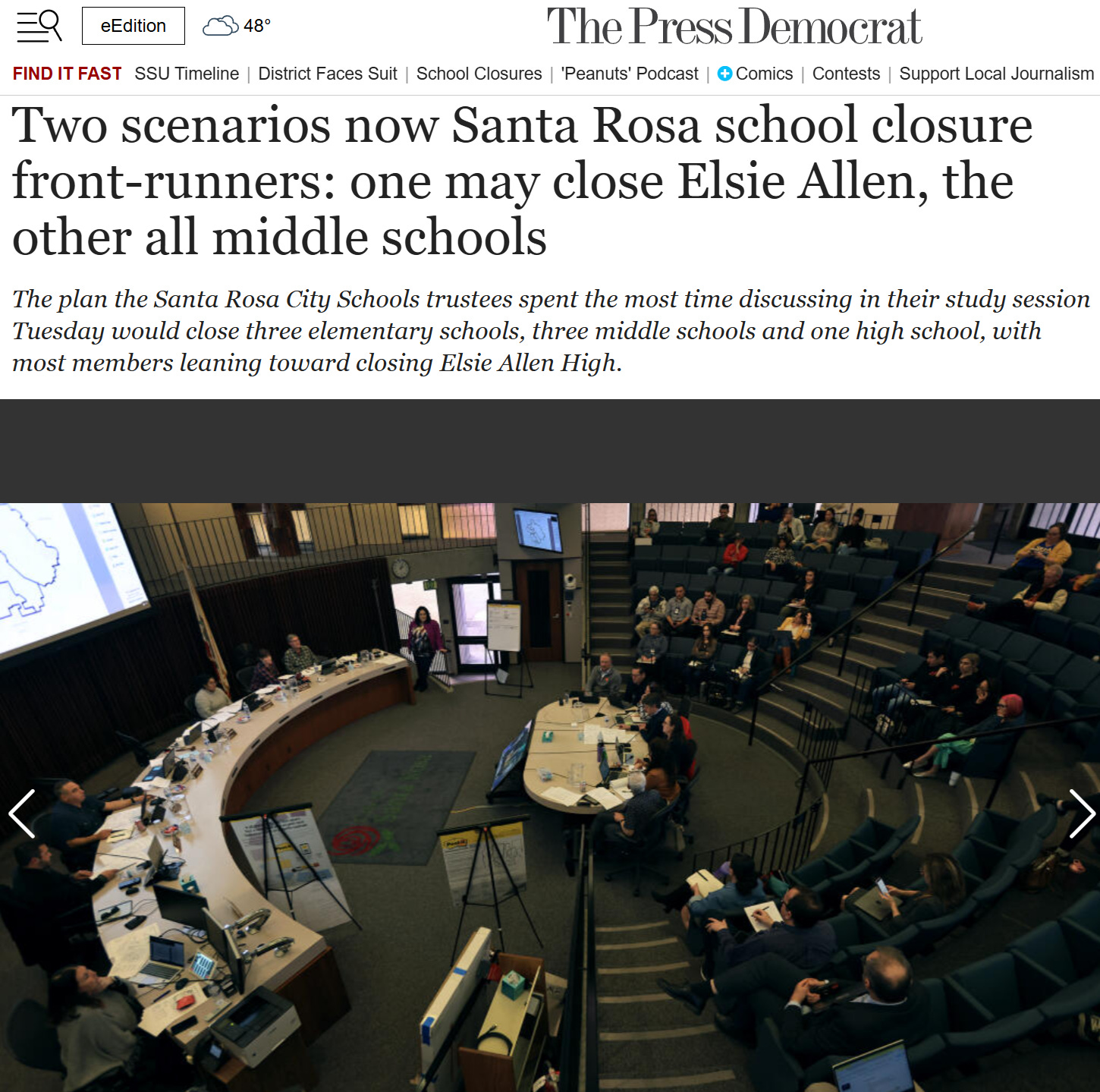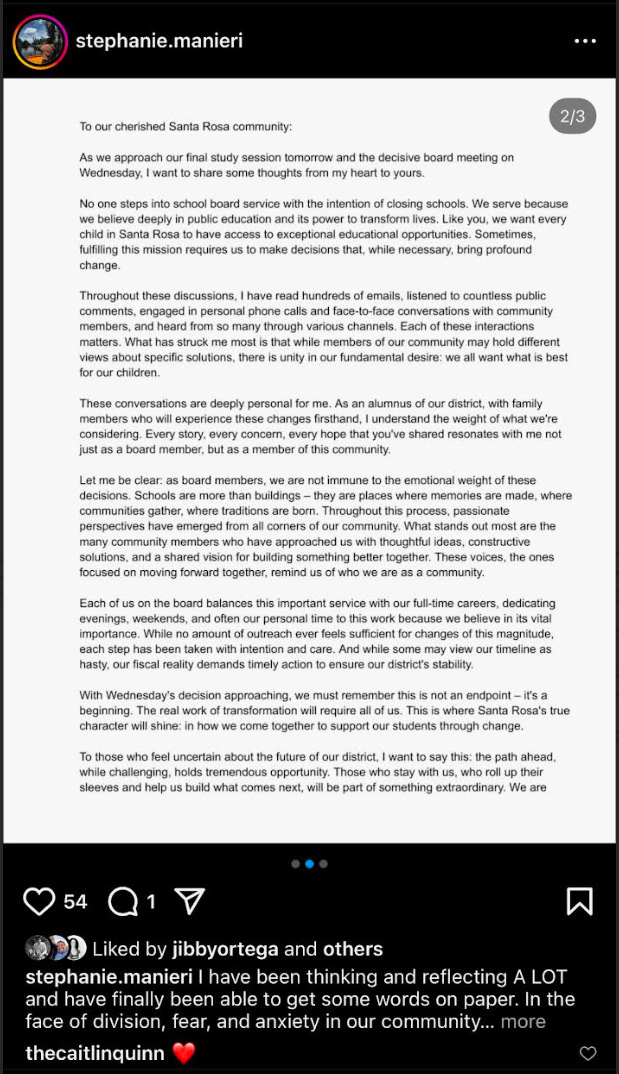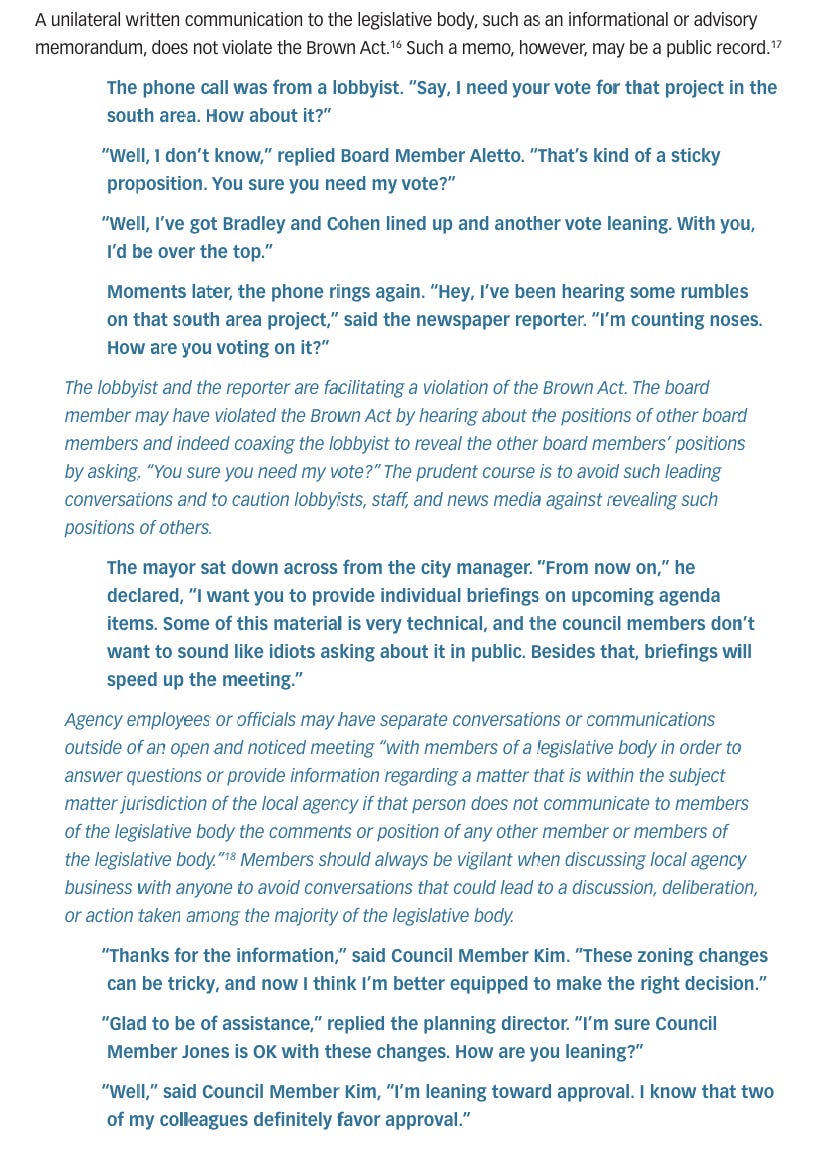Did Santa Rosa City Schools Trustees Violate the Brown Act Regarding Today's Impending School Closures?
SRCS Vice President Stephanie Manieri and a fellow 'unnamed' trustee posted an open letter to the community touting support for Elsie Allen HS to remain open
Amidst a $30M budget deficit, Santa Rosa City Schools (SRCS) trustees will make one of the most momentous decisions in district memory this evening. Santa Rosa City Schools trustees met yesterday morning for a final work session regarding impending school closures.
Per yesterday’s article in The Press Democrat:
By the end of the five-hour session, they had narrowed their choices of which schools should close by the end of the year to two scenarios. Neither reflects the district’s original closure scenario, which called for shuttering three elementary schools, one middle school and one high school. Instead, the first scenario, which trustees spent more time discussing, would close three elementary schools, three middle schools and one high school. This plan, called the 3-3-1 scenario, would phase in over three years. Under that plan:
Brook Hill Elementary School and Albert Biella Elementary school would close the first year. Steele Lane Elementary School would close the following year.
Hilliard Comstock and Santa Rosa middle schools would close the first year, as would Elsie Allen High School.
The first year, Piner High School and Santa Rosa High School would become grade 7-12 campuses, absorbing all middle schoolers.
Two of the charter schools — Cesar Chavez Language Academy and Santa Rosa French American Charter — would move to the empty campuses at Hillard Comstock
Middle School and Santa Rosa Middle School, respectively. Middle schoolers from Cesar Chavez, Santa Rosa French American Charter and Santa Rosa Charter School for the Arts would phase onto Montgomery High’s and Santa Rosa High’s campuses within the first two years.
The third year, construction would be underway to close Rincon Valley Middle School and move it onto Maria Carrillo High School in a 7-12 model.
There were two versions of the 3-3-1 scenario: one that closes Elsie Allen High School and one that closes Montgomery High School.
After a contentious conversation about between trustees, they chose to move forward with the version of the 3-3-1 scenario that would close Elsie Allen.
Their decision was not a formal vote and their reasoning was varied.
Trustee Nick Caston said his choice was based on the option that would displace the smallest number of students. Elsie Allen has 200 fewer students than Montgomery.
He also noted that middle school students who live in the Elsie Allen district boundary may already be traveling far from where they live to attend a Santa Rosa school, so closing Elsie would maintain the transportation challenge that already exists, rather than creating a new one.
Trustee Stephanie Manieri responded to Caston’s comments, saying that “challenges” are better described as inequities.
“The disinvestments in Elsie have been a systematic thing … because of racism, because of sometimes situations out of our control,” she said. “I will not support any scenario that closes Elsie Allen. I will not consider that. We will leave an entire community without any access to public education.”
Manieri also asked whether the board would be subject to any litigation following a closure of Elsie Allen, on the grounds of incorrect procedures that examined equity impacts. Superintendent Daisy Morales said the district’s legal team does not anticipate they will be open to legal action because the district followed the state guidelines for closure.
Board President Roxanne McNally was also hesitant about selecting Elsie Allen, stating she had “serious concerns.”
She also pushed back against the transportation issue Caston raised.
“Just because there are students already transporting out of the area, doesn’t mean the 800 students who are already (at Elsie) can,” McNally said.
Trustee Jeremy De La Torre called attention to the number of students who choose not to go to Elsie Allen and transfer to other district schools.
“Our community continues to send their students not to Elsie Allen,” he said. “It is not the teachers’ fault, the students’ fault, the programs’ fault … I would like to see Elsie Allen grow, but that is a big ‘what if.’”
This school year, 173 students requested to transfer out of Elsie Allen. There were six requests for students to attend the school. In comparison, 135 students requested to transfer out of Montgomery High School coupled with 30 requests to attend the school.
“I just want to make sure that it's clear that the decline in numbers in the last couple years has been due to safety and the community begging this board for support,” said Trustee Sarah Jenkins on the topic of transfers. “I don’t think we can sacrifice one school to roll the dice on another.”
Ultimately, the trustees voted 4-2 to select Elsie Allen as the closure option for the 3-3-1 scenario. Manieri and McNally cast the dissenting votes.
That scenario would save the district $12.7 million the first year and $14.1 million the next two years, well above the target savings goal of $12.5 million.
The second scenario, called the 3-4-0 plan, would save all high schools from closure but would close all middle schools.
Under this scenario:
Brook Hill Elementary School and Albert Biella Elementary school would close the first year. Steele Lane Elementary School would close the following year.
Hilliard Comstock Middle School, Santa Rosa Middle School and herbert Slater Middle School would all close the first year.
Santa Rosa High School, Piner High School, Elsie Allen High School and Montgomery High School would turn into 7-12 models.
The second year, multiple charters would move onto elementary sites, creating additional cost savings by closing current charter sites.
The third year, construction would be underway to close Rincon Valley Middle School and move it onto Maria Carrillo High School in a 7-12 model.
There was some pushback from trustees about the all-or-nothing approach of closing all middle schools, but ultimately trustees wanted to consider a scenario that would save high schools.
The scenario would save less than the target savings of $12.5 million. The district projects savings of $8.6 million in year one, $10 million in year two and $12.5 by year three.
The focus of the discussion around the 7-12 closure model is its feasibility. At a previous work session, the scenario was repeatedly described as “difficult” to pull off by August due to capacity concerns and issues with existing facilities.
“As much as I like the idea of 7-12 I don’t want to force that on the entire community,” McNally said. “The logistics of facilities and making those things happen by August seems unrealistic.”
Jenkins felt the scenario “takes out parent choice.”
Trustees will continue their conversation about the two scenario finalists on Wednesday night, likely to be a long meeting. But by the end, the Santa Rosa community will finally know which of their schools will close.
The meeting takes place at Santa Rosa City Hall. It starts at 6 p.m.
Report For America corps member Adriana Gutierrez covers education and child welfare issues for The Press Democrat. You can reach her at Adriana.Gutierrez@pressdemocrat.com.
SRCS Vice President Stephanie Manieri recently posted the following open letter to the community and critical update regarding school closures from her Instagram account:
Trustee Omar Medina liked Vice President Manieri’s posts on Instagram to tout his support in favor of Elsie Allen High School remaining open.
Per the 2024 League of California Cities Guide to the Ralph M. Brown Act:
The Brown Act covers members of virtually every type of local government body, elected or appointed, decision-making or advisory. Some types of private organizations are covered, as are newly elected members of a legislative body, even before they take office. Similarly, meetings subject to the Brown Act are not limited to face-to-face gatherings. They also include any communication medium or device through which a majority of a legislative body discusses, deliberates, or takes action on an item of business outside of a noticed meeting. They include meetings held from remote locations by teleconference or videoconference.
New communication technologies present new Brown Act challenges. For example, common email practices of forwarding or replying to messages can easily lead to a serial meeting prohibited by the Brown Act, as can participation by members of a legislative body in an internet chatroom or blog dialogue. Social Media posts, comments, and “likes” can result in a Brown Act violation. Communicating during meetings using electronic technology (such as laptop computers, tablets, or smart phones) may create the perception that private communications are influencing the outcome of decisions, and some state legislatures have banned the practice. On the other hand, widespread video streaming and videoconferencing of meetings has greatly expanded public access to the decision-making process.
The Brown Act provides that “[a] majority of the members of a legislative body shall not, outside a meeting … use a series of communications of any kind, directly or through intermediaries, to discuss, deliberate, or take action on any item of business that is within the subject matter jurisdiction of the legislative body.” The problem with serial meetings is the process, which deprives the public of an opportunity for meaningful observation of and participation in legislative body decision-making.
The serial meeting may occur by either a “daisy chain” or a “hub and spoke” sequence. In the daisy chain scenario, Member A contacts Member B, Member B contacts Member C, Member C contacts Member D, and so on until a quorum has discussed, deliberated, or taken action on an item within the legislative body’s subject matter jurisdiction. The hub and spoke process involves at least two scenarios. In the f irst scenario, Member A (the hub) sequentially contacts Members B, C, D, and so on (the spokes) until a quorum has been contacted. In the second scenario, a staff member (the hub), functioning as an intermediary for the legislative body or one of its members, communicates with a majority of members (the spokes) one by one for discussion, deliberation, or a decision on a proposed action.13 Another example of a serial meeting is when a chief executive officer (the hub) briefs a majority of members (the spokes) prior to a formal meeting and, in the process, information about the members’ respective views is revealed. Each of these scenarios violates the Brown Act.
A legislative body member has the right, if not the duty, to meet with constituents to address their concerns. That member also has the right to confer with a colleague (but not with a majority of the body, counting the member) or appropriate staff about local agency business. An employee or official of a local agency may engage in separate conversations or communications outside of an open and noticed meeting “with members of a legislative body in order to answer questions or provide information regarding a matter that is within the subject matter jurisdiction of the local agency if that person does not communicate to members of the legislative body the comments or position of any other member or members of the legislative body.”14
The Brown Act is violated, however, if several one-on-one meetings or conferences lead to a discussion, deliberation, or action by a majority. In one case, a violation occurred when a quorum of a city council, by a letter that had been circulated among members outside of a formal meeting, directed staff to take action in an eminent domain proceeding.15
Particular care should be exercised when staff briefings of legislative body members occur by email because of the ease of using the “reply all” option that may inadvertently result in a Brown Act violation. Staff should consider using the “bcc” (blind carbon copy) option when addressing an email to multiple members of the legislative body and remind recipients not to “reply all.”
Social media should also be used with care. A member of the legislative body cannot respond directly to any communication on an internet-based social media platform that is made, posted, or shared by any other member of the legislative body. This applies to matters within the subject matter jurisdiction of the legislative body. For example, if one member of a legislative body “likes” a social media post of one other member of the same body, that could violate the Brown Act, depending on the nature of the post.19
Finally, electronic communications (such as text messaging) among members of a legislative body during a public meeting should be discouraged. If such communications are sent to a majority of members of the body, either directly or through an intermediary, on a matter on the meeting agenda, that could violate the Brown Act. Electronic communications sent to less than a majority of members of the body during a quasi-judicial proceeding could potentially raise due process concerns, even if not per se prohibited by the Brown Act. Additionally, some legislative bodies have rules governing electronic communications during meetings of the legislative body and how their members should proceed if they receive a communication on an agenda item that is not part of the record or not part of an agenda packet.
I am issuing the following Cure & Correct letter regarding the potential Brown Act violation to the SRCS Board and Sonoma County District Attorney by email, and mailed a hard copy:
While I stand in solidarity to keep Elsie Allen High School open, the decision making process must remain fair and unbiased. As a private citizen, I have the legal right to express a biased outside opinion outside of Board Meetings. However, school board trustees must remain vigilant in their adherence to the Ralph M. Brown Act.
Romans 13:1
Let every person be subject to the governing authorities. For there is no authority except from God, and those that exist have been instituted by God.
Santa Rosa City Schools Paid Me a $50k Settlement After Violating the Law
I am the former Executive Assistant to the Santa Rosa City Schools District (SRCS) Board & Superintendent. I was illegally forced out as a protected whistleblower within the State of California. I sent hundreds of emails to the County of Sonoma, the district, law enforcement and local governing bodies to report potential violations of state and federal …












